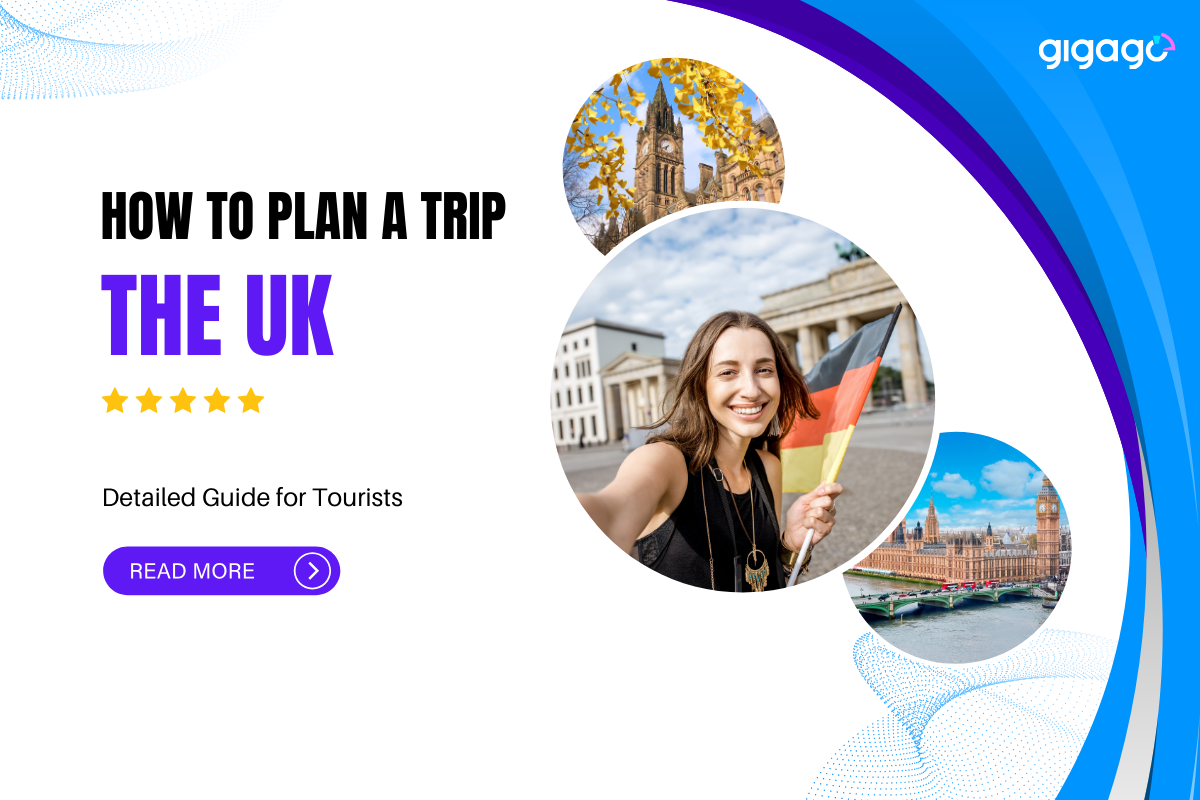How to Plan a Trip to the UK – Ultimate Guide
Planning a trip to the UK can be an exhilarating yet daunting task. With its rich history, diverse culture, and stunning landscapes, the UK offers a plethora of experiences for every type of traveler. Whether you are visiting iconic landmarks, indulging in local cuisine, or exploring quaint villages, careful planning is essential to make the most of your journey.

Plan a trip to the UK
This ultimate guide will walk you through everything you need to know to plan your trip to the UK effectively, from when to go and how long to stay, to budgeting and navigating the country.
I. How Far in Advance Should I Plan My Trip to the UK?
To have a really great trip to the UK, it’s super important to start planning early. Think of it like this: the earlier you book your flights and hotels, the more money you save and the more choices you have. Plus, if you start planning early, you have more time to find fun things to do and learn about the places you’ll visit.
Don’t wait until the last minute! Planning ahead means you won’t feel rushed or stressed trying to book things at the last second. This way, you can relax and look forward to your amazing UK adventure!
II. UK Trip Planning Tools
Planning a UK trip is made easy with a variety of helpful apps:
- TripIt: Keeps all your travel plans, like flights and hotels, organized in one place.
- Google Maps: Your trustworthy guide to navigate cities and find nearby attractions.
- Citymapper: Perfect for getting around using public transportation in cities.
- Airbnb: Discover unique and charming places to stay, from apartments to cottages.
- Yelp: Find great restaurants and read reviews from other diners.
Beyond these handy apps, a wealth of online resources can enhance your planning experience. Websites like VisitBritain offer a treasure trove of information on destinations and travel tips, while forums like TripAdvisor provide valuable insights and firsthand accounts from fellow travelers. For visual inspiration and travel ideas, social media platforms like Instagram and Pinterest are excellent resources. With these tools at your fingertips, you’ll be well-prepared to embark on an unforgettable UK adventure.
III. What is the Best Time to Visit the UK?

One of the best places in the UK
The best time to visit the UK largely depends on your preferences regarding weather, crowds, and events. Each season offers its own unique charm, making it important to consider what you hope to experience during your trip.
- Spring (March to May): Think blooming flowers, pleasant weather, and gardens bursting with color. It’s a lovely time for exploring and enjoying outdoor festivals. Just be ready for a little rain now and then.
- Summer (June to August): Summer means long, sunny days, perfect for sightseeing and enjoying everything the UK has to offer. But keep in mind, it’s the busiest time of year, so expect more crowds and higher prices.
- Autumn (September to November): Picture a countryside painted with the vibrant hues of autumn leaves – reds, golds, and yellows everywhere you look. The weather is still mild, and the crowds have thinned out. It’s a great time hiking and enjoying cozy pubs.
- Winter (December to February): Winter can be chilly, but it brings a special kind of magic, especially around Christmas. Think of twinkling lights, festive markets, and cozy evenings by the fireplace. If you’re a fan of winter sports, the Scottish Highlands offer fantastic skiing and snowboarding.
No matter when you choose to visit the UK, you’re sure to have an unforgettable trip!
IV. How Long to Stay in the UK?
Determining how long to stay in the UK depends on your travel goals and interests. Whether you’re looking for a quick getaway or an extended exploration, understanding your priorities will help you craft the perfect itinerary.
Short Trips (Around 1 Week):
- Perfect for: Seeing the most famous sights.
- Focus on: Major cities like London, Edinburgh, and Bath.
- Must-sees: Buckingham Palace, the Tower of London, the Roman Baths.
- Why it’s great: You’ll experience the highlights without feeling overwhelmed.
Longer Adventures (2+ Weeks):
- Perfect for: Really getting to know the UK.
- Focus on: Exploring beyond the big cities, discovering hidden gems, and experiencing local life.
- Must-dos: Venturing into the countryside, visiting charming villages, maybe even trying a local pub quiz!
- Why it’s great: You’ll have time to soak up the culture, meet people, and create lasting memories.
Remember to: Find a balance between sightseeing and relaxation. Don’t forget to slow down, enjoy a peaceful walk in the park, or treat yourself to a traditional cream tea.
V. Best Things to Do in the UK
The UK is full of diverse activities and attractions that cater to a wide range of interests. From historical landmarks to natural wonders, here are some of the best things to do during your trip.
1. Explore Historic Landmarks
The UK is home to a wealth of historic landmarks that tell the story of its past. Must-visit sites include the Tower of London, Stonehenge, and Westminster Abbey. Each location offers guided tours, informative exhibits, and breathtaking architecture that transport you back in time.
2. Experience Local Culture
Immerse yourself in the local culture by attending traditional events, visiting museums, and exploring art galleries. The British Museum in London houses an impressive collection of artifacts from around the world, while the Tate Modern showcases contemporary art. Don’t miss the opportunity to catch a West End show or enjoy live music at local pubs.
3. Discover Natural Beauty
From the rugged coastline of Cornwall to the rolling hills of the Cotswolds, the UK’s natural beauty is awe-inspiring. Take a hike in the Lake District, visit the Cliffs of Moher in Wales, or explore the Scottish Highlands. National parks and nature reserves offer endless opportunities for outdoor adventures, including hiking, cycling, and wildlife spotting.
4. Indulge in Culinary Delights
British cuisine has evolved over the years, and today, it boasts a diverse array of flavors and influences. Sample traditional dishes such as fish and chips, shepherd’s pie, and afternoon tea. Explore local markets, dine at Michelin-starred restaurants, or join a food tour to discover the culinary scene in different regions.
VI. Getting to the UK
Traveling to the UK is relatively straightforward, with several options available depending on your location and preferences. The most common mode of transportation for international travelers is by air.
If you’re traveling from a faraway country, flying is usually the simplest option. The UK boasts major airports like Heathrow, Gatwick, and Manchester, welcoming flights from all corners of the globe.
When you’re booking your flight, think about:
- Layovers: Do you have to switch planes anywhere?
- Travel time: How long will the whole journey take?
- Airline reputation: Are some airlines known for being better than others?
- Price: Check different airlines to see which one has the best price!
Other Ways to Go:
- Train: If you’re already in Europe, you can take a train to the UK. The Eurostar train connects London with Paris and Brussels.
- Boat: You can also take a ferry (a big boat!) from mainland Europe to the UK.
Taking the train or ferry can be really cool because you get to see beautiful scenery along the way!
VII. Getting Around the UK
Once you’ve arrived in the UK, navigating the country is relatively easy thanks to its extensive transportation network. Here are some of the most common ways to get around.
Navigating the United Kingdom’s extensive transportation network is remarkably straightforward. Visitors and residents alike can readily utilize the comprehensive public transportation system, encompassing the renowned London Underground, buses, and trams.
For those who prefer independent travel, rental cars provide flexibility, particularly for exploring picturesque rural areas. However, it is essential to note that driving is on the left-hand side of the road in the UK. Taxis and ride-sharing services offer convenient door-to-door transportation, especially for shorter distances or when public transportation is unavailable. With a variety of efficient and accessible options, traversing the UK proves to be a seamless experience.
VIII. Money and Budget
The UK can be an expensive place to visit, so planning your budget is essential for a stress-free trip. Here’s what you need to know:
Daily Costs: Expect to spend around £50-£150 per day. This can vary widely depending on your travel style and where you go (London is pricier than smaller cities).
Saving Money:
- Free Activities: Many museums and art galleries offer free admission, especially in London.
- Discount Passes: Consider a city pass for discounted entry to multiple attractions.
- Eat Like a Local: Pubs and markets often have delicious and affordable meals.
Remember: These are just estimates. Create a detailed budget breakdown based on your specific travel plans and preferences.
IX. Mobile Internet in the UK

Vodafone SIM card in the UK
Staying online is easier than ever in the UK! Here’s what you need to know:
- Local SIM Cards: The easiest option for most travelers. Grab a prepaid SIM card when you arrive at the airport or any convenience store. Popular providers include EE, Vodafone, and O2.
- eSIMs: If your phone supports it, activate an eSIM before you travel or upon arrival for a seamless experience.
- Free Wi-Fi: Widely available in cafes, restaurants, and public areas. Great for checking emails but not ideal for constant navigation or sensitive tasks.
Pro Tip: For maximum flexibility and peace of mind, combine a local SIM card (or eSIM) with free Wi-Fi access.
X. Using Your Phone While Traveling in the UK
Using your phone while traveling in the UK can enhance your experience, but it’s essential to understand how to maximize its functionality.
1. International Roaming
Before your trip, check with your mobile carrier regarding international roaming options. Some carriers offer affordable plans for travelers, while others may charge high fees for data usage abroad. Consider disabling data roaming to avoid unexpected charges and rely on Wi-Fi instead.
2. Download Useful Apps
Downloading essential travel apps before your trip can save you time and hassle. Navigation apps like Google Maps and Citymapper can help you find your way around cities, while translation apps can assist with language barriers. Additionally, consider downloading offline maps for areas with limited connectivity.
3. Staying Safe Online
While using public Wi-Fi, prioritize your online security by avoiding sensitive transactions, such as banking or shopping. Use a virtual private network (VPN) to encrypt your internet connection and protect your personal information while browsing.
XI. Passport and Visa Requirements for the UK
Understanding the passport and visa requirements for entering the UK is crucial for a smooth travel experience. Depending on your nationality, the regulations may vary.
Before you even leave for the UK, double-check your passport’s validity as some countries require it to be valid for a certain period beyond your trip. Depending on your nationality, you may also need to apply for a visa in advance. When you arrive, be prepared to present your passport, visa (if applicable), and any supporting documents at customs and immigration.
XII. Conclusion
Planning a trip to the UK is an exciting endeavor filled with possibilities. By following this ultimate guide, you can navigate the complexities of travel planning and create a memorable experience tailored to your interests. From understanding when to visit and how long to stay, to exploring the best activities and managing your budget, each aspect plays a vital role in ensuring a successful journey. Embrace the adventure, immerse yourself in the rich culture, and savor every moment of your time in the UK. Happy travels!

